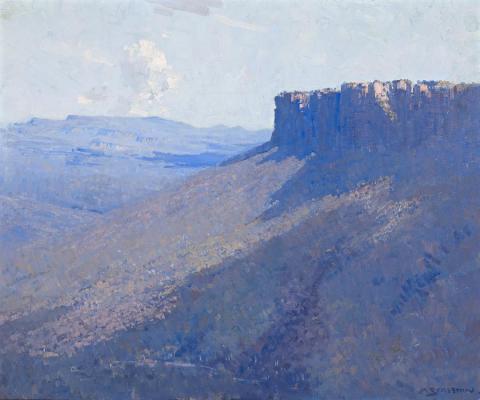MOUNT ROSEA, GRAMPIANS, 1920
ARTHUR STREETON
oil on canvas
63.5 x 76.0 cm
signed lower right: A STREETON
Collection of Mr Arthur Baillieu, Melbourne
Estate of Keith McRoberts, Melbourne
Leonard Joel, Melbourne, 13 April 1988, lot 69
Rogowki collection, Melbourne
Leonard Joel, Melbourne, 23 February 1998, lot 120
Estate of a private collection, Melbourne
Mr Arthur Streeton's Exhibition of Paintings of the Grampian Mountains, Athenaeum Hall, Melbourne, 1–6 November 1920, cat. 5 (as 'Monta Rosea')
Art Gallery of South Australia, Adelaide, 1970
‘Mr Streeton's Pictures', The Argus, Melbourne, 2 November 1920, p. 9
‘Mr Arthur Streeton Among the Grampians', The Age, Melbourne, 2 November 1920, p. 8
Streeton, A., The Arthur Streeton Catalogue, self published, Melbourne, 1935, cat. 751 (under 1921, as 'Mount Rosea', collection of Mr Arthur Baillieu)
The sentiment of Australia's vast spaces is admirably conveyed in a collection of paintings of the Grampians and Dandenongs by Mr. Arthur Streeton, that will be on view at the Athenaeum Hall, Collins street, to-day'.1 So began The Argusreview of Streeton's exhibition that offered Melburnians and visitors a splendid diversion during the Cup Week of 1920. Mount Rosea was singled out, with others, for special mention as being among those paintings in which the artist was successful in solving the difficulties 'of changing sunlight and shadow ... giving a fine suggestion of the beautiful colour of the Australian mountains'. The Age was even more enthusiastic, its critic describing the exhibition as 'an important event in Australian art'. 'It marks', the writer continued, 'the return to his position of preeminence of our greatest landscape painter.'2 Warming to his subject, the reviewer wrote,'The pictures of the lovely scenery of the Grampians Mountains that are shown in the present exhibition are more poetical and more romantic than anything that Mr Streeton has previously done.' He continued, 'What Streeton has added to his wonderful technique is a warmer note of sentiment.' Then comes the curious observation, 'Here and there that note is over-emphasised, as in the picture of Monta Rosea, where the simplicity of the effect departs from sincerity.' To the modern eye, this is exactly why Mount Rosea has such appeal - the striking yet powerful simplicity with which Streeton has achieved his noble ends. The view, which is considered to be one of the most spectacular in the region, is bold in its sweep, as sunlight touches the cliff tops, upright, before they move downwards into the valleys. A symphony in sunlight with movements in blue, it captures the grandeur of the scene with a bravura that is unmistakenly Streeton at his panoramic best. The elevated position appealed both for view and ennoblement. Streeton wrote, 'When painting among the Grampian Hills, I found that my best subjects were visible from the crests of the Peaks ... once perched upon the Sundial Peak, above the world, the reward is evident in a vast expanse of pale blue over myriad gums rising to Mount Rosea, or over Boronia Peak to Stawell 20 miles to the East.'3 It was Streeton's first visit to the Grampians and he responded with such empathy and pride that paintings such as Hall's Gap, the Grampians, 1920, in the collection of the National Gallery of Australia, Canberra, and Mount Rosea, Grampians have been adopted as part of our national image.
1.'Mr Streeton's Pictures', The Argus, Melbourne, 2 November 1920, p. 9
2.'Mr Arthur Streeton Among the Grampians', The Age, Melbourne, 2 November 1920, p. 8
3. Arthur Streeton, Notes for memoirs, Streeton family papers, quoted in Eagle, M., The Oil Paintings of Arthur Streeton in the National Gallery of Australia, National Gallery of Australia, Canberra, 1994, p. 159
DAVID THOMAS
